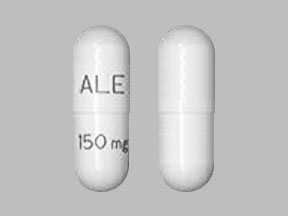Alecensa Side Effects
Generic name: alectinib
Note: This document provides detailed information about Alecensa Side Effects associated with alectinib. Some dosage forms listed on this page may not apply specifically to the brand name Alecensa.
Applies to alectinib: oral capsule.
Serious side effects of Alecensa
Along with its needed effects, alectinib (the active ingredient contained in Alecensa) may cause some unwanted effects. Although not all of these side effects may occur, if they do occur they may need medical attention.
Check with your doctor immediately if any of the following side effects occur while taking alectinib:
More common side effects
- bloody urine
- chest pain or discomfort
- cough
- decreased frequency or amount of urine
- difficulty with moving
- increased blood pressure
- increased thirst
- joint pain or swelling
- loss of appetite
- lower back or side pain
- lightheadedness, dizziness, or fainting
- muscle aching or cramping
- muscle pains or stiffness
- nausea
- slow or irregular heartbeat
- swelling of the face, fingers, or lower legs
- trouble breathing
- unusual tiredness or weakness
- vomiting
- weight gain
Less common side effects
- clay-colored stools
- dark urine
- decreased appetite
- fever
- headache
- itching or skin rash
- stomach pain or tenderness
- yellow eyes or skin
Rare side effects
- difficulty breathing
Incidence not known
- back, leg, or stomach pains
- bleeding gums
- chills
- general body swelling
- nosebleeds
- pale skin
- sore throat
Other side effects of Alecensa
Some side effects of alectinib may occur that usually do not need medical attention. These side effects may go away during treatment as your body adjusts to the medicine. Also, your health care professional may be able to tell you about ways to prevent or reduce some of these side effects.
Check with your health care professional if any of the following side effects continue or are bothersome or if you have any questions about them:
More common side effects
- back pain
- bloating or swelling of the face, arms, hands, lower legs, or feet
- blurred vision
- difficulty having a bowel movement
- double vision
- lack or loss of strength
- rapid weight gain
- rash with flat lesions or small raised lesions on the skin
- seeing double
- seeing floating dark spots or material before the eyes
- swelling around the eyes
- tingling of the hands or feet
- unusual weight gain or loss
- vision changes
Less common side effects
- change in taste
- loss of taste
For healthcare professionals
Applies to alectinib: oral capsule.
Hematologic adverse events
- Very common (10% or more): Anemia (62%), lymphopenia (14%), neutropenia (14%)
- Postmarketing reports: Hemolytic anemia[Ref]
Hepatic
- Very common (10% or more): Increased AST (51%), increased alkaline phosphatase (47%), hyperbilirubinemia (39%), increased ALT (34%)[Ref]
Musculoskeletal
- Very common (10% or more): Increased CPK (43%), myalgia/musculoskeletal pain (29%), back pain (12%), back pain (12%)[Ref]
Other
- Very common (10% or more): Fatigue/asthenia (26%), edema (e.g., peripheral edema, edema, eyelid edema, localized edema, face edema) (22%)[Ref]
Metabolic
- Very common (10% or more): Hyperglycemia (36%), hypocalcemia (32%), hypokalemia (29%), hypophosphatemia (21%), hyponatremia (20%), increased weight (11%)[Ref]
Gastrointestinal
- Very common (10% or more): Constipation (34%), nausea (18%), diarrhea (16%), vomiting (12%)[Ref]
Renal
- Very common (10% or more): Increased creatinine (e.g., increased blood creatinine, creatinine renal clearance decreased, glomerular filtration rate decreased, acute kidney injury) (28%)[Ref]
Dermatologic
- Very common (10% or more): Rash (e.g., acneiform dermatitis, erythema, and different types of rash [macular, papular, maculopapular, generalized, and pruritic]) (15%)
- Common (1% to 10%): Photosensitivity[Ref]
Nervous system
- Very common (10% or more): Headache (17%)
- Common (1% to 10%): Dysgeusia/hypogeusia[Ref]
Respiratory
- Very common (10% or more): Cough (19%), dyspnea (16%)
- Uncommon (0.1% to 1%): Interstitial lung disease[Ref]
Ocular
- Very common (10% or more): Vision disorder (e.g., blurred vision, vitreous floaters, visual impairment, reduced visual acuity, asthenopia, diplopia) (10%)[Ref]
Cardiovascular
- Very common (10% or more): Bradycardia (11%)[Ref]
References
1. (2015) "Product Information. Alecensa (alectinib)." Genentech
Frequently asked questions
- What is the mechanism of action for Alecensa (alectinib)?
- How long do you take Alecensa for?
- How effective is Alecensa for ALK-positive NSCLC?
- How does Alecensa work?
- What is Alecensa used to treat?
More about Alecensa (alectinib)
- Check interactions
- Compare alternatives
- Pricing & coupons
- Reviews (2)
- Drug images
- Dosage information
- Patient tips
- During pregnancy
- FDA approval history
- Drug class: multikinase inhibitors
- Breastfeeding
- En español
Patient resources
Professional resources
Related treatment guides
Further information
Alecensa side effects can vary depending on the individual. Always consult your healthcare provider to ensure the information displayed on this page applies to your personal circumstances.
Note: Medication side effects may be underreported. If you are experiencing side effects that are not listed, submit a report to the FDA by following this guide.

